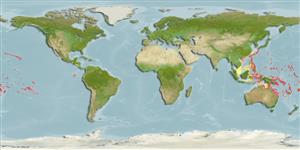Classification / Names
Common names from other countries
Main reference
Size / Weight / Age
Max length : 15.0 cm TL male/unsexed; (Ref. 9710)
Environment
Marine; reef-associated; non-migratory; depth range 21 - 81 m (Ref. 9710)
Climate / Range
Tropical, preferred ?; 30°N - 28°S
Distribution
Short description
Dorsal
spines
(total): 15 - 16;
Dorsal
soft rays
(total): 15-16;
Anal
spines: 3;
Anal
soft rays: 14 - 17. Males light blue with 8 black stripes on the lower 2/3 of the body (the posterior end of the uppermost yellow, the lowermost stripes extending the adjacent anal fin); females light blue with a vertical black bar above the eye and spots on the forehead; both sexes with a broad submarginal band on the dorsal and anal fins; females with broad submarginal band on the caudal-fin lobes.
IUCN Red List Status (Ref. 115185)
Threat to humans
Harmless
Human uses
Aquarium: commercial
More information
Common namesSynonymsMetabolismPredatorsEcotoxicologyReproductionMaturitySpawningFecundityEggsEgg development
ReferencesAquacultureAquaculture profileStrainsGeneticsAllele frequenciesHeritabilityDiseasesProcessingMass conversion
Tools
Special reports
Download XML
Internet sources
Estimates of some properties based on models
Phylogenetic diversity index
PD50 = 0.5010 many relatives (e.g. carps) 0.5 - 2.0 few relatives (e.g. lungfishes)
Trophic Level
3.4 ±0.45 se; Based on food items.
Resilience
High, minimum population doubling time less than 15 months (Preliminary K or Fecundity.)
Vulnerability
Low vulnerability (23 of 100)
Price category
